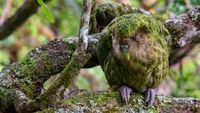Kakapo
 From Conservapedia
From Conservapedia | Kakapo | |
|---|---|

| |
| Scientific classification | |
| Kingdom Information | |
| Domain | Eukaryota |
| Kingdom | Animalia |
| Subkingdom | Bilateria |
| Branch | Deuterostomia |
| Phylum Information | |
| Phylum | Chordata |
| Sub-phylum | Vertebrata |
| Infraphylum | Gnathostomata |
| Class Information | |
| Superclass | Tetrapoda |
| Class | Aves |
| Sub-class | Neornithes |
| Infra-class | Neoaves |
| Order Information | |
| Superorder | Psittacimorphae |
| Order | Psittaciformes |
| Family Information | |
| Family | Strigopidae |
| Tribe Information | |
| Tribe | Strigopini |
| Genus Information | |
| Genus | Strigops |
| Species Information | |
| Species | S. habroptila |
| Population statistics | |
| Population | 149 (2018 est.)[1] |
| Conservation status | Critically endangered[2] |
The kakapo or owl parrot (Strigops habitropila), is a species of parrot of the family Strigopidae, found currently on several islands of New Zealand, and unique for being the only flightless parrot.
The Kakapo is critically endangered, mainly due to hunting by the Maori and European settlers, and introduced predators like dogs, cats, and rats. There is a large recovery effort going on, which has resulted in 213 living birds.
Contents
- 1 Description
- 2 Range and habitat
- 3 Threats
- 4 References
Description[edit]
The kakapo is large; although flightless, it is the largest living parrot species. Adult birds are 23 to 25 inches in length, and weigh 2 to 9 pounds. Males are larger than females. The plumage is yellow-green in color, with brownish-gray mottling; the appearance of the feathers is soft, in keeping with its ground dwelling habits. A light-grayish set of feathers make up a facial disk, giving the bird an owl-like appearance
Range and habitat[edit]
The kakapo was once found throughout New Zealand, including both North and South islands, and Stewart Island. Introduced predators reduced their numbers considerably to the point that they are likely extinct within their former natural range. Several programs aimed at preventing complete extinction were carried out begining in 1980, with the goal of collecting the remaining birds and transferring them to islands which had no introduced predators[3], among them:
- Codfish Island/Whenua Hou
- Anchor Island
- Little Barrier Island/Hauturu-o-Toi
It lives in moist wooded areas, primarily mossy Nothofagus or other forests with an adjacent water supply. They are variable and adaptable, as their habitats have included coastal lands, scrub and tussock grasslands, and sub-alpine montane forests, from sea level to 2,100 feet elevation.
Threats[edit]
The ICUN has classified this bird as "critically endangered". As of 2018 the Department of Conservation listed the total number of living kakapos to be 149; this number is down from 154 just two years previously, and down significantly by some 80% during the last 100 years[4][5]. Being flightless combined with low reproduction and mating rates, the kakapo is susceptible to predation by species introduced by man, among them two species of rats (Rattus rattus, Rattus exulans), which have been known to feed on eggs; the ermine (Mustela erminea), a species of weasel which is capable of hunting and killing the birds; and the domestic cat (Felis catus), which is responsible for some 50% of kakapo kills on Sullivan's Island. Further compounding the problems is disease; outbreaks of septicaemia[6] and cloacitis[7] have been reported.
As of September, 2019, the kakapo population has risen to 213[8].
References[edit]
- ↑ https://www.iucnredlist.org/species/22685245/129751169#population
- ↑ https://www.iucnredlist.org/species/22685245/129751169
- ↑ https://www.biographic.com/kakapo-comeback/
- ↑ https://www.iucnredlist.org/species/22685245/129751169#population
- ↑ http://datazone.birdlife.org/species/factsheet/kakapo-strigops-habroptila/text
- ↑ https://www.researchgate.net/publication/7529089_Erysipelas_in_the_critically_endangered_kakapo_Strigops_habroptilus
- ↑ https://www.ncbi.nlm.nih.gov/pubmed/25186371
- ↑ https://www.doc.govt.nz/news/media-releases/2019/kakapo-population-reaches-a-record-high-of-213/
Categories: [Birds] [Parrots] [Flightless Birds] [New Zealand Parrots]
↧ Download as ZWI file | Last modified: 02/14/2023 03:21:23 | 14 views
☰ Source: https://www.conservapedia.com/Kakapo | License: CC BY-SA 3.0
 ZWI signed:
ZWI signed: KSF
KSF